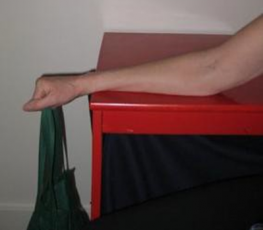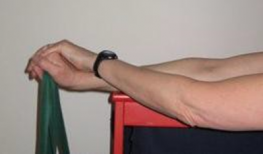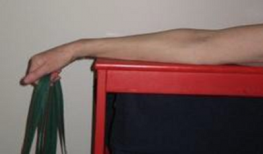Lateral Epicondyle Tendinopathy Toolkit: Section E - Exercise Prescription: Difference between revisions
Evan Thomas (talk | contribs) No edit summary |
Evan Thomas (talk | contribs) No edit summary |
||
| Line 30: | Line 30: | ||
== Supervised Eccentric Exercise and Stretching Program (Stasinopoulos et al 2006<ref>Stasinopoulos D, Stasinopoulos I. (2006) Comparison of effects of cyriax physiotherapy, a supervised exercise programme and polarized polychromatic non-coherent light (bioptron light) for the treatment of lateral epicondylosis. Clinical Rehabilitation. 2006; 20(1): 12-23.</ref>)<br> == | == Supervised Eccentric Exercise and Stretching Program (Stasinopoulos et al 2006<ref>Stasinopoulos D, Stasinopoulos I. (2006) Comparison of effects of cyriax physiotherapy, a supervised exercise programme and polarized polychromatic non-coherent light (bioptron light) for the treatment of lateral epicondylosis. Clinical Rehabilitation. 2006; 20(1): 12-23.</ref>)<br> == | ||
...<br> | {| cellpadding="2" border="1" style="border: 1px solid darkgray;" | ||
|- | |||
| width="500" | | |||
*3 times a week, 4 weeks. | |||
*Forearm supported in pronation with elbow extended. | |||
*Wrist extended as high as possible then lowered into flexion slowly counting to 30, return to starting position using the other hand. | |||
*3 sets of 10, 1 minute rest between sets. | |||
*Resistance, free weights. | |||
*Increase resistance when the exercise is pain-free. | |||
*Exercise with mild pain. Stop if pain becomes disabling. | |||
*Passive stretching of the extensor carpi radialis brevis tendon (ECRB) done by therapist 3 times before and 3 times after the eccentric exercise. Forearm pronated, elbow extended, wrist flexed and ulnar deviated. Hold 30-45 seconds. 30 second rest between stretches. | |||
<br> | |||
<br> | |||
<br> | |||
<br> | |||
<br> | |||
| width="300" | | |||
[[Image:LET Appendix C Fig2a.png|center|264x154px|Fig 2a of LET App C]]''' Figure 2A''' <br> [[Image:LET Appendix C Fig2b.png|center|264x154px|Fig 2b of LET App C]]''' Figure 2B''' | |||
Extend the wrist using the unaffected hand (2A). Allow the wrist to flex (eccentric contraction of wrist extensors) (2B). The original research used hand held weights. We have substituted a bag with weights. | |||
|} | |||
<br> | |||
== The “Tyler Twist” Eccentric Wrist Extensor Exercise (Tyler et al 2010<ref>Tyler T, Thomas G, Nicholas S, McHugh M. Addition of isolated wrist extensor eccentric exercise to standard treatment for chronic lateral epicondylosis: a prospective randomized trial. Journal Of Shoulder And Elbow Surgery. Sep 2010; 19(6): 917-922.</ref>)<br> == | == The “Tyler Twist” Eccentric Wrist Extensor Exercise (Tyler et al 2010<ref>Tyler T, Thomas G, Nicholas S, McHugh M. Addition of isolated wrist extensor eccentric exercise to standard treatment for chronic lateral epicondylosis: a prospective randomized trial. Journal Of Shoulder And Elbow Surgery. Sep 2010; 19(6): 917-922.</ref>)<br> == | ||
Revision as of 14:55, 12 August 2013
Concentric/Eccentric Home Exercise Program (Peterson et al 2011[1])[edit | edit source]
|
Figure 1 |
Supervised Eccentric Exercise and Stretching Program (Stasinopoulos et al 2006[2])
[edit | edit source]
|
Figure 2A Figure 2B Extend the wrist using the unaffected hand (2A). Allow the wrist to flex (eccentric contraction of wrist extensors) (2B). The original research used hand held weights. We have substituted a bag with weights. |
The “Tyler Twist” Eccentric Wrist Extensor Exercise (Tyler et al 2010[3])
[edit | edit source]
...
Download Lateral Epicondyle Tendinopathy Toolkit: Appendix C - Details of Exercise Prescription[edit | edit source]
References[edit | edit source]
References will automatically be added here, see adding references tutorial.
- ↑ Peterson M, Butler S, Eriksson M, Svardsudd K. A randomized controlled trial of exercise versus wait-list in chronic tennis elbow (lateral epicondylosis). Uppsala Journal of Medical Science. 2011; 116: 269-279.
- ↑ Stasinopoulos D, Stasinopoulos I. (2006) Comparison of effects of cyriax physiotherapy, a supervised exercise programme and polarized polychromatic non-coherent light (bioptron light) for the treatment of lateral epicondylosis. Clinical Rehabilitation. 2006; 20(1): 12-23.
- ↑ Tyler T, Thomas G, Nicholas S, McHugh M. Addition of isolated wrist extensor eccentric exercise to standard treatment for chronic lateral epicondylosis: a prospective randomized trial. Journal Of Shoulder And Elbow Surgery. Sep 2010; 19(6): 917-922.









